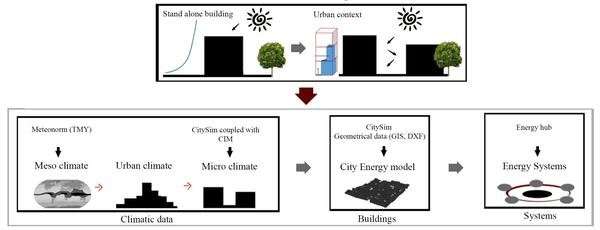Designing urban energy systems based on the urban climate

As cities grow at an ever-faster pace, concerns about global warming rise and fossil fuels become increasingly scarce, cities will have to adopt more sustainable energy solutions. EPFL researchers have developed a model that can be used to design urban energy systems by analyzing the building not as a standalone structure but as one piece in an urban puzzle.
Up to now, architects, engineers, urban planners and public authorities have not taken account of how the urban climate affects a building's energy requirements when designing energy systems for renovation and construction projects. But thanks to a model developed by researchers at EPFL, they will now be able to adopt a holistic approach to the energy needs of a neighborhood – or an entire city – in order to create integrated and more sustainable energy systems. The researchers' work has been published in Applied Energy.
Evaluating energy needs on an urban scale is the cornerstone of the concept of energy hubs. The new model, developed by the Urban Systems group within EPFL's Solar Energy and Building Physics Laboratory (LESO) in the School of Architecture, Civil and Environmental Engineering, combines an urban climate model with a building simulator and energy system optimization. "I felt it was important to be able to determine what the energy needs of all the buildings in a city would be in order to create an energy system for it," says Dasun Perera, who is working on energy system design. "Heat, cold and wind all have an influence on energy needs, and buildings have an impact on each other, too."
For their project, the LESO team chose to analyze cities in very different climates: Switzerland and Palestine. "In one location, demand for heating is high, while in the other there is a greater need for air conditioning. But this is all going to change," explains Dasaraden Mauree, who was also involved in a related study that was published in Sustainability, MDPI. For that study, Mauree analyzed the EPFL campus as if it were a Swiss city in its own right. He ran various scenarios over a timeframe of nearly a century, in an effort to understand what the impact of climate change will be in the years 2039, 2069 and 2099. "People don't necessarily think that far ahead, yet that is essential when we're renovating and constructing buildings that meet the Minergie P energy-efficiency standard." In a century's time, Switzerland's climate will be much more Mediterranean, so demand for air conditioning will rise.
The researchers have shown how buildings can influence energy integration and have proven that energy optimization at the neighborhood or community level is more cost effective than optimizing the energy consumption of a single building. Going forward, rapid urbanization, increasingly dense construction and the impact of climate change will all have to be factored into any solution to this challenge. "Extreme urban climates play a major role in energy needs. If you don't take account of the environment and microclimate in cities, your energy system will fail, and you will most likely fall well short of your expectations," says Perera.
More information: Dasaraden Mauree et al. A New Framework to Evaluate Urban Design Using Urban Microclimatic Modeling in Future Climatic Conditions, Sustainability (2018). DOI: 10.3390/su10041134
Quantifying the impact of urban climate by extending the boundaries of urban energy system modeling. Applied Energy, DOI: 10.1016/j.apenergy.2018.04.004
Provided by Ecole Polytechnique Federale de Lausanne





















